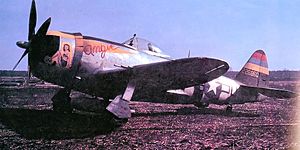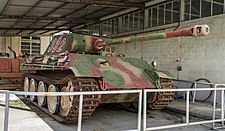Battle of Dompaire facts for kids
Quick facts for kids Battle of Dompaire |
|||||||
|---|---|---|---|---|---|---|---|
| Part of World War II | |||||||
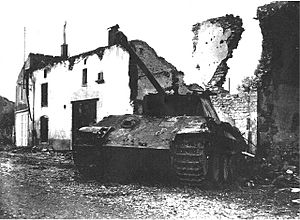 Panther tank knocked out in the village of Madonne-et-Lamerey during the battle |
|||||||
|
|||||||
| Belligerents | |||||||
| Commanders and leaders | |||||||
| Strength | |||||||
|
|
|
||||||
| Casualties and losses | |||||||
| 44 killed 7 tanks destroyed 1 fighter bomber |
350 killed 1,000 wounded 69 tanks destroyed |
||||||
The Battle of Dompaire was a big fight between French and German tank forces. It happened near the town of Dompaire in France during World War II. The battle took place from September 12 to 14, 1944. It was part of the Lorraine campaign on the Western Front.
This battle was important because a new German tank unit, the 112th Panzer Brigade, tried to stop the Allied advance. They faced a skilled French unit, the French 2nd Armoured Division. This French unit was led by General Philippe Leclerc.
The German brigade was new and didn't have much experience. They were caught in many ambushes by the French tanks. American planes also helped the French from the air. The French tanks and US fighter planes worked together. They destroyed many German tanks with very few losses of their own. The Germans had to retreat. This slowed down their plans for a counter-attack in the Lorraine area.
Contents
What Led to the Battle?
The French 2nd Armoured Division was led by General Philippe Leclerc. They had already fought well in the Battle of Normandy. They caused heavy losses to the German 9th Panzer Division. After breaking out of Normandy in August, they helped free Paris.
After Paris, General Charles de Gaulle sent them to join the new French 1st Army. This army was forming in Provence. The 2nd Armoured Division was very experienced. They had fought for over three years. They used American tanks, weapons, and supplies. Many of their soldiers were veterans from French colonies in French North Africa.
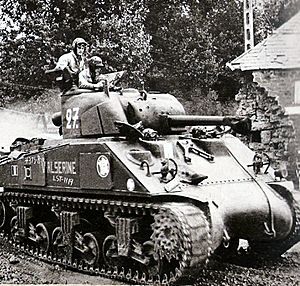
General Leclerc wanted his division to stay with the American army. This was for political reasons. So, his division joined the US XV Corps in Lorraine. This American unit was part of General George Patton's US Third Army. Patton's army had done very well in early September. They had captured important river crossings on the Moselle river.
But the Allied advance started to slow down. They were running out of supplies, especially fuel. Also, German defenses were getting stronger. The quick French-American advance surprised the German High Command. Adolf Hitler wanted to gather a strong tank force. He planned a counter-attack in Lorraine.
On September 8, 1944, a German tank brigade tried to attack. They wanted to stop the US XX Corps. But they were pushed back and lost many tanks. Two days later, the French 2nd Armoured Division split into three groups. These were called Groupement tactique groups.
One group, 'Groupement Langlade', led the French advance. It was commanded by Colonel Paul de Langlade. This group headed towards Epinal. It had infantry soldiers in half-tracks. It also had two tank battalions. Each tank group had infantry, sixteen M4 Sherman tanks, and a few M10 Wolverine tank destroyers.
French and German Movements
'Groupement Langlade' moved towards Vittel. They broke through German defenses and captured the town on September 11. They took many prisoners. At the same time, German generals moved their tanks to block the Allies.
One German general, Hasso von Manteuffel, decided to ignore Hitler's orders. He told Colonel Horst von Usedom to divide his 112th Panzer Brigade. Their goal was to recapture Vittel. On the evening of September 12, about 45 Panther tanks entered Dompaire. Another group of 45 Panzer IV tanks moved towards Darney.
Leclerc set up his command post near Vittel. 'Groupement Langlade' continued east. They stopped for the night near Dompaire and Damas-aux-Bois. Local French people warned them about German troops nearby. The Germans had moved west but didn't scout the area well.
The German tank brigade had powerful tanks. But their crews were very young and lacked experience. Also, the Germans didn't have much air support or artillery. This was a big problem compared to the Allied forces.
The Battle Begins
Colonel Langlade planned to send 'Groupe Massu' to attack Dompaire. This town was in a narrow valley. 'Groupe Minjonnet' would attack from Ville-sur-Illon towards Damas. Damas was on the main road between Dompaire and Epinal. They would also take over the hills around Dompaire. From these high spots, Langlade could use his artillery effectively.
Fighting in Dompaire
On the evening of September 12, German tanks reached Dompaire. Von Usedom sent the Panther tanks to positions near Madonne-et-Lamerey. They didn't know they were exposed from the west. He only had a few anti-tank guns and howitzers. The Panzer IV tanks stayed in Darney, sheltering from the rain. This meant the two German tank groups were not in touch. Von Usedom hoped the bad weather would keep Allied planes on the ground.
The French took their positions easily. They planned to surprise the Germans. 'Groupe Massu' moved to the hills south and southwest of Dompaire. They wanted to control the town. Forty Shermans and seven M10 tank destroyers refueled and rearmed in the dark.
A French scouting group first met the Germans on the southwestern edge of Dompaire. In a quick fight, one Panther tank and two anti-tank guns were destroyed. One French Sherman was knocked out, and another was damaged. The French pulled back. This let the Germans continue moving southwest of Dompaire. Both sides fired shots as night fell. French artillery fired on all roads into the village to block movement. Langlade also arranged for Allied air support.
Meanwhile, 'Groupe Minjonnet' sent scouts towards Damas. Three French tank destroyers advanced. They found no resistance at first. But when they entered the village, they met Panther tanks. Two German tanks were hit and destroyed. The Germans retreated. The French lost two jeeps and a half-track. The French then pulled back to Ville-sur-Illon. They set up artillery on the hills south of Dompaire.
The next morning, French infantry and five Shermans forced the Germans out of Lavieville. Then, the troops moved towards Dompaire. The French had the town almost surrounded. Panther tanks moved south of Madonne-et-Lamerey. This was hilly and wooded land. The French had placed their M10 tank destroyers on the slopes, ready to ambush. Two tank destroyers quickly spotted and hit three Panthers from 900 meters away. This stopped the German advance. French 105mm howitzers also started firing on the Germans. Then, they attacked Damas and captured it quickly. After this, they forced the Germans out of Maison Rouges. They captured fifty Germans. This cut the main road between Dompaire and Epinal.
US Air Support Arrives
A US officer, Colonel Tower, was with 'Groupement Langlade'. He was in charge of coordinating air support. He had planned for British planes to help. But they were busy on another mission. Instead, he arranged attacks by P-47 Thunderbolt fighter-bombers. These planes were from the 406th Fighter-Bomber Group.
At 8 AM, the P-47D Thunderbolts attacked the German tanks at Madonne-et-Lamerey. They used rockets, bombs, and machine guns. The results were devastating. The French said the attack broke up the German column. At least eight tanks were badly damaged, destroyed, or left behind. The town was also heavily damaged.
The French groups tried to surround the Germans in Dompaire. They took over the main roads. Sherman tanks advanced to the western edge of Dompaire. Other armored vehicles and M10 tank destroyers climbed the hills behind the Germans. French tank destroyers destroyed two more Panthers. The rest of 'Groupe Minjonnet' blocked the road to Epinal.
At 11 AM on September 13, P-47 fighter-bombers launched their second attack. The French used flares to show targets. Despite some confusion with French vehicles, the attacks further broke up the German forces. Many young German tank crews panicked and left their vehicles.
Battle at Ville-sur-Illon
The Panther tank unit was in a very bad spot. The Panzer IV tank unit and infantry were in Darney. They were called to help. They advanced from the south towards Dompaire.
As they moved, the Germans put the French in trouble. 'Groupe Minjonnet' was in danger of being attacked from two sides. Also, Colonel Langlade's command post was in Ville-sur-Illon. This village was on the hills south of the town, right in the Germans' path. German shelling hit Langlade's headquarters, causing some confusion.
The French saw the Germans around 1:30 PM. But the German infantry stopped to loot a supply depot. They lost contact with their tanks. Langlade quickly organized an artillery barrage. He also used a few M4 Shermans, M10 tank destroyers, and anti-tank guns. The leading Panzer IV tanks ran into heavy fire. They suffered losses immediately. The Shermans shot at the tracks of the German tanks to stop them. Then they hit them on the sides. Two German tanks were destroyed up close. Three more were knocked out in an ambush by M10s.
Meanwhile, the German infantry arrived. But French machine-gun fire pinned them down. Langlade moved his command post to a safer place. General Leclerc heard about the battle and was worried. But 'Groupement Billotte' came to help from the north. This group was led by Pierre Billotte, a very experienced tank veteran. He agreed with Langlade and Massu not to retreat. They decided to keep fighting the Germans.
German Retreat
The Panther tank unit stuck in Dompaire suffered two more air attacks that afternoon. These caused more damage. Small groups of German tanks tried to break through the French circle. But these attacks were costly. The German tanks were surprised and hit on their sides. The French tanks were hidden well on the hillsides.
By the end of the day, the German tank brigade had lost most of its tanks. The Panther unit in Dompaire had only four tanks left. The Panzer IV unit had lost most of its tanks too. The German infantry had been pushed back. Only seventeen German tanks were still able to fight.
The remaining Germans left Dompaire by the north. Massu then entered Dompaire. The town was heavily damaged. The French found the remains of thirty-three destroyed German tanks. Thirteen were hit by French tanks. Sixteen Panthers were damaged by air attacks. Four were left behind intact. Langlade then retook Ville-sur-Illon later that evening. It was abandoned.
Von Luck's Counterattack
The German command tried to send help to the 112th Panzer Brigade. On September 14, Colonel Hans von Luck tried to advance from Hennecourt. He had tanks and infantry from the 21st Panzer Division. 'Groupe Minjonnet' was also reinforced by 'Groupe Putz'.
At Hennecourt, the Germans were quickly stopped by artillery fire. The Panzer IV company moved towards Damas. But they lost five tanks quickly and had to retreat. Another attack was also pushed back. After these failures, the Germans gave up further attacks. Von Luck's group and the survivors of the 112th Panzer Brigade retreated towards Epinal. Von Luck wanted to save his forces for a planned counter-attack in Lorraine.
What Happened Next?
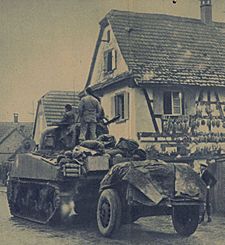
The French secured their positions and looked at the damage. They were surprised to find several intact German tanks. Two of them were Panther tanks. The French checked the tanks. They saw that they were very new. They had been made in Germany in July and delivered in August. One Panther tank, 'AusF 332', was captured intact in Dompaire. It was later displayed outside a famous building in Paris.
For the Germans, Dompaire meant the almost complete destruction of a valuable tank brigade. After two days of fighting, the 112th Panzer Brigade went from 96 tanks to only 21. The German High Command reported losing 34 Panthers and 26 Panzer IVs. They also had over 350 dead, 1,000 wounded, and several guns lost. This was one of their heaviest losses of tanks on the Western Front in a single day. The 112th Panzer Brigade never recovered. What was left of it joined another German tank division.
For the Allies, this battle showed that Germany was still bringing new units to fight. For Leclerc's 2nd Armoured Division, the victory at Dompaire was a huge boost to their spirits. They had almost destroyed a German tank brigade with new tanks. This showed how skilled their commanders were and how brave their soldiers were.
Many French soldiers received awards for their bravery. The French had low losses. They lost five Sherman tanks, two light tanks, two jeeps, two half-tracks, and 44 soldiers. The help from the US fighter-bombers was also very important. They destroyed many German vehicles. They only lost one of their own planes. An American general called this a "brilliant example" of air and ground forces working together.
The German defeat at Dompaire had big effects. The US XV Army Corps reached the Moselle river by September 17. A German infantry division was surrounded. The rest of the German LXIV Army Corps had to retreat. Two days later, the US forces crossed the Moselle. They joined other US units. Even after this defeat, Hitler still ordered a counter-attack. Another tank battle happened later at battle of Arracourt. The Germans lost again. The French 2nd Armoured Division continued fighting until the end of the war.
What Remains Today?
The Panther tank 'AUS F 332' survived the war. It was displayed in Paris for many years. It was restored in the 1970s. Today, it is kept at the Musée des Blindés (Tank Museum) in Saumur, France.
-
The Panther tank 'AUS F 332' was captured at Dompaire by the French. It is now on display at the Musée des Blindés in Saumur.


